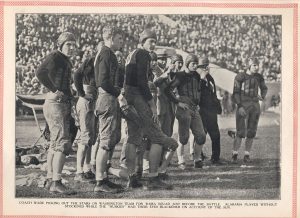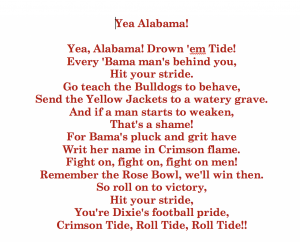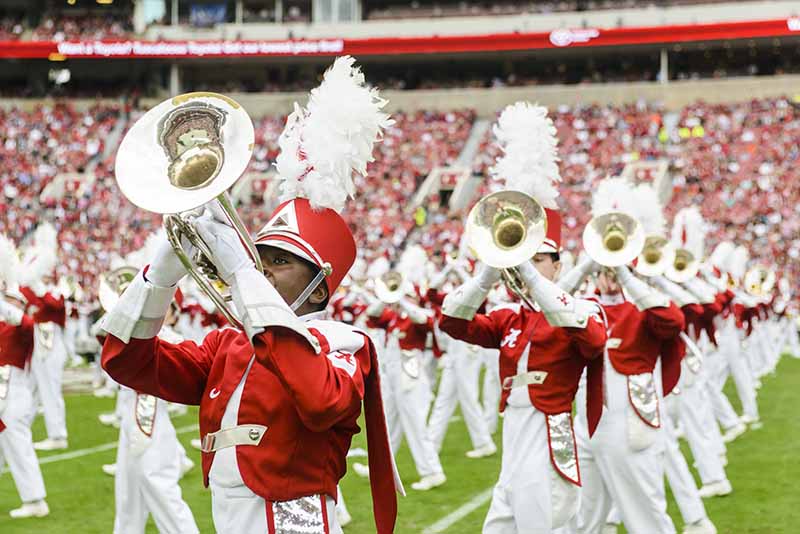The University of Alabama opened in 1831, but “Yea, Alabama!” wasn’t written until 1926.
For most of that time, no one felt a void; varsity sports didn’t exist on campus until 1892. There were songs, including “The Alabama University March: Composed and Respectfully Dedicated to the Faculty of the University of Alabama,” composed by A.P. Pfister (1839), “The Corolla March” (1896) and The Crimson and The White” (1905). Helen Vickers wrote the “Alma Mater” (1908). While good glee club selections, they didn’t get the blood pumping.

As football and other varsity sports became popular, students wanted a fight song to sing at pep rallies and games. In 1912 Dr. George H. Denny came to Alabama from Washington and Lee University in Virginia. That school’s song, “The Washington and Lee Swing,” was adapted for “The Alabama Swing” but students didn’t want another school’s fight song. Another adaptation, “Glory, Glory, Alabama” — sung to the tune of the “Battle Hymn of the Republic” — didn’t work either. The Crimson White took up the cause of advocating for a unique UA song.
By the mid-1920s, the football team had an identity – the Crimson Tide – a cheer squad, a Million Dollar Band, and its first regional championships. But still no song.
By 1925, among a host of sports victories, the football team had again won the Southern Intercollegiate Athletic Association championship. The Crimson White pressed on: “Along with a championship team we should have a championship song. … We want a new song and we want it now!”
In October 1925 campus humor magazine Rammer Jammer offered $50 for the best fight song. On Jan. 1, 1926, the Crimson Tide claimed its first national championship in the Rose Bowl. The desire for a fight song at that point was “a mania,” according to author David Battles.
Submissions poured in until the Jan. 15, 1926, deadline. In March the winner was announced: Ethelred “Epp” Sykes, The Crimson White editor who had written the pleas for a song. Sykes donated his prize to pay for an arrangement to be written so the Million Dollar Band could play “Yea, Alabama!” by the 1926 football season.
 The Lyrics
The Lyrics
The meaning of the lyrics are rooted in that 1925 season and 1926 Rose Bowl.
How are we teaching the bulldogs to behave?
The Georgia Bulldogs lost to the Crimson Tide 27-0 that season.
Who are the Yellow Jackets and how are we sending them to a watery grave?
In 1925 the Georgia Tech Yellow Jackets lost to Alabama 7-0 in rainy weather. “A watery grave” might refer to the rain that day, or to being beaten by the Tide.
Why isn’t Auburn mentioned?
The Tide-Tiger rivalry was on a 40-year break when “Yea, Alabama!” was written.
Why are we remembering the Rose Bowl?


After a 9-0 season in which Alabama gave up only one touchdown, the team accepted an invitation to meet the University of Washington Huskies in the Rose Bowl. The match-up was met with national derision. Football was ascendant in Northern and Western schools, and the Rose Bowl was supposed to be the great East-West showdown. Southerners, it was assumed, had no business there.
The Crimson Tide and Coach Wallace Wade boarded the train to Pasadena, California, knowing they represented not only The University of Alabama, but Southern football and the South. After winning 20-19 and having Johnny Mack Brown named Most Valuable Player, the team was met by cheering crowds all along the route home and received a champions’ welcome back in Tuscaloosa.
Every time fans sing our fight song, they celebrate not just one win, not just one championship, but the moment when the Crimson Tide brought Southern football onto the national stage.
Sources for this article include “Yea, Alabama! The Uncensored Journal of the University of Alabama (Vol. 3 – 1901-1926)” by UA alumnus David M. Battles (2018); “The Crimson Tide: An Illustrated History of Football at The University of Alabama” by UA alumnus Winston Groom (2000); and the Paul W. Bryant Museum.
